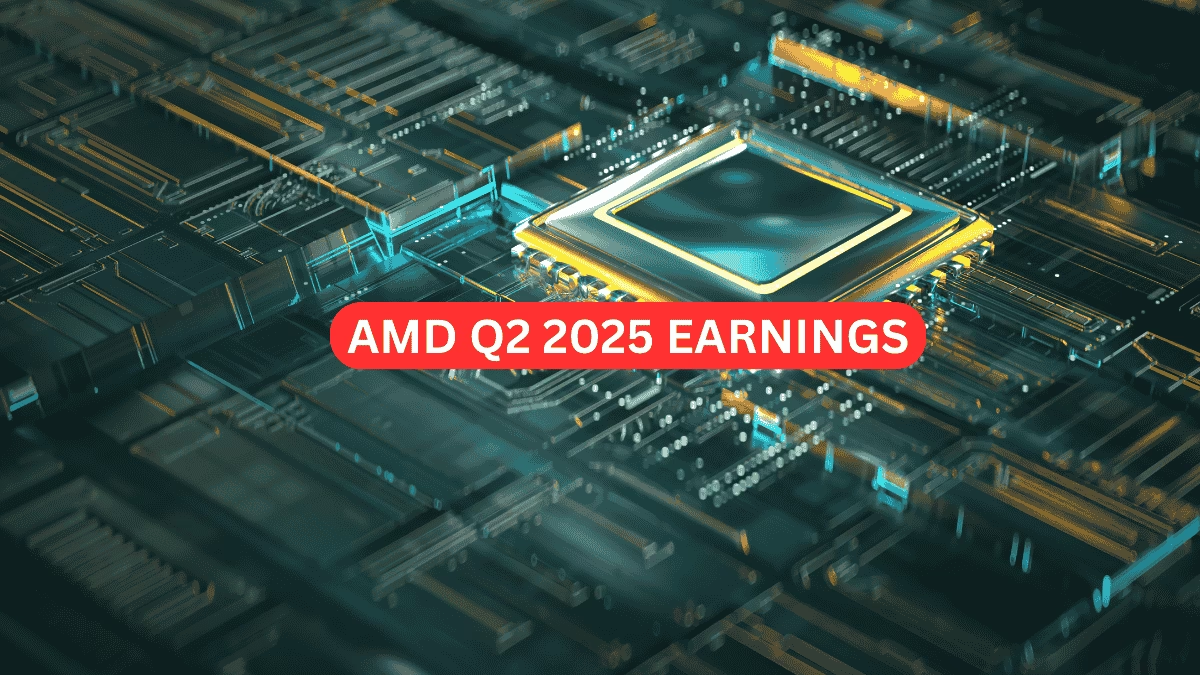Latest Earnings Recap : AMD Earnings
AMD Earnings: AMD delivered a landmark quarter, posting $7.7 billion in revenue—a substantial 32% jump year-over-year and a result that surpassed analyst predictions. Adjusted earnings per share held steady at $0.48, exactly meeting expectations. However, the company faced margin pressure, with GAAP gross margin slipping to 40%, largely due to an $800 million inventory write-down. This write-down tied back to U.S. export controls on advanced AI chips for China, serving as a reminder that regulatory and geopolitical risks remain a reality for global semiconductor leaders.
Diving deeper, AMD’s Data Center revenue reached $3.2 billion, marking a 14% annual increase, while the combined Gaming & Client segments surged 69% to $3.6 billion. Meanwhile, Embedded revenue came in at $824 million, showing a slight year-over-year softness. Despite this impressive revenue growth, AMD shares retreated 3.2% following the earnings announcement, as investors recalibrated expectations around margin headwinds and inventory adjustments. Nevertheless, the company’s stock price has soared 45% in 2025, reflecting broad market optimism about AMD’s direction and momentum.
About AMD
Established in 1969 in Santa Clara, AMD was often described as the perennial underdog, a “second source” processor supplier competing against the likes of Intel and Nvidia. In recent years, however, AMD has undergone a dramatic transformation through relentless R&D investments and high-impact acquisitions—ATI (graphics), Xilinx (adaptive computing), and Silo AI (AI capabilities). These moves diversified its portfolio and strengthened its competitive edge.
Today, AMD stands as an industry powerhouse, developing high-performance CPUs (like the Ryzen and EPYC lines), GPUs, and adaptive accelerators. The company’s products now underpin the global AI and cloud computing revolutions, powering everything from hyperscale data centers run by Microsoft and Meta to cutting-edge AI research. Strategic partnerships have enabled AMD to work at the unmissable intersection of hardware innovation and digital transformation, positioning the firm as a key architect of tomorrow’s computing landscape.
ALSO READ : GPT OSS: OpenAI’s Open-Weight Language Model Revolution
Future Plans
AMD’s future roadmap is ambitious and laser-focused on three core strategies:
- AI Hardware Leadership: AMD is accelerating production and rollouts of its next-gen MI350 and soon-to-launch MI400 AI accelerators. These high-powered chips are intended for technology giants like Microsoft, Meta, and OpenAI, helping fuel the core infrastructure of modern artificial intelligence and putting AMD in direct competition with Nvidia at center court of the AI race.
- Open AI Ecosystem: By forging deep and strategic partnerships, AMD aims to promote and standardize open AI development platforms. This approach, focused on accessibility and customizability, is designed to broaden AI adoption across industries—from large-scale enterprise to smaller businesses and emerging developers—while also nurturing a robust ecosystem of software and hardware innovation.
- Innovative Product Launches: Recent releases such as the Zen 5-based CPUs and the next generation of Ryzen AI chips power everything from mission-critical data centers to AI-enhanced personal computers (“Copilot+” devices, for example). AMD is leaning heavily into products that blur the line between consumer and enterprise computing, reflecting the broader trend of AI permeating daily life.
- Growth Outlook: Management’s guidance for the next quarter is $8.7 billion (± $300 million) in revenue—a forecast notably excluding potential upside from China, underscoring just how strong North American and international demand for AI hardware currently is.
AMD Price History: July–August 2025 : AMD Earnings
AMD’s stock price has reflected both the optimism around its AI-driven strategy and the volatility tied to market expectations:
| Date | Close Price ($) |
|---|---|
| 2025-07-01 | 140.00 |
| 2025-07-10 | 150.00 |
| 2025-07-20 | 160.00 |
| 2025-07-25 | 165.00 |
| 2025-07-28 | 172.64 |
| 2025-07-29 | 179.51 |
| 2025-07-30 | 176.31 |
| 2025-07-31 | 176.78 |
| 2025-08-01 | 171.70 |
| 2025-08-04 | 176.00 |
| 2025-08-05 | 174.31 |
From a base of $140 in July, shares peaked at $179.51 and most recently settled near $174. This dramatic rise coincided with heightened excitement surrounding AMD’s AI and high-performance computing leadership, though the post-earnings dip illustrates how quickly sentiment can shift in reaction to margin or regulatory developments.
Graphics Segment Perspective
AMD’s graphics division remains a critical engine. Its latest Radeon GPUs consistently attract gamers, creators, and professional users—the bedrock of AMD’s traditional strength—while Instinct AI accelerators fuel growth in data centers worldwide. As businesses, researchers, and consumers all demand more visual and computational power, the graphics segment is capturing robust increases in sales, especially to hyperscale and enterprise customers. This broad market traction provides AMD a hedge, balancing AI bets with established and growing markets in gaming and content creation.
My Perspective : AMD Earnings
AMD’s story over the past year is not just about strong earnings—it’s about transformation:
- AI is now the primary growth engine. AMD’s shift to advanced AI chips, in tandem with fostering open AI ecosystems, has recalibrated the market’s perception. The company’s ability to ink deals with top-tier tech players speaks volumes about its renewed competitive vigor.
- Temporary headwinds, lasting opportunity. Margin pressure from export bans and inventory write-downs is unfortunate but not terminal; these setbacks pale in comparison to the immense structural opportunities AI presents. AMD’s continued investment in R&D and partnerships should help weather short-term volatility.
- Stock performance and investor sentiment. With the stock up 45% year-to-date, investors clearly see AMD as a major beneficiary of AI’s coming decade. But the volatility following earnings also underscores the need for careful execution—especially around costs and regulatory navigation.
Bottom Line
AMD’s future is firmly tied to its execution in AI hardware leadership, ecosystem expansion, and product innovation. If management delivers on this roadmap and skillfully manages regulatory shocks, AMD is set to deepen its role in AI and high-performance computing—with the momentum and vision to merit close attention from investors and the entire tech industry.


1 thought on “AMD Earnings: Riding the AI Wave”
Comments are closed.